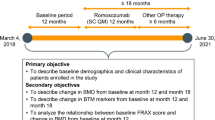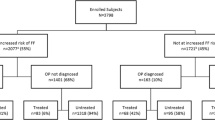Abstract
The aims of this study are to determine the proportion of patients at high risk for major osteoporotic and hip fractures in a Japanese cohort with rheumatoid arthritis (RA) and to determine if a care gap exists for high-risk patients. The Fracture Risk Assessment Tool (FRAX®) was administered to 3,970 Japanese patients with RA enrolled in the Institute of Rheumatology Rheumatoid Arthritis cohort study with (n = 276) and without (n = 3,694) the use of bone mineral density (BMD) measurement. The study population had a mean age of 62 years and was 84% female. Among the 1,522 patients ≥65 years of age, 661 (43%) and 1,304 (86%) were at high risk for a major osteoporotic fracture (10-year probability >20%) and hip fracture (>3%), respectively. Among patients at high risk for a major osteoporotic fracture (n = 723), only 453 (63%) and 320 (44%) reported taking any osteoporosis medications and bisphosphonates, respectively. Among female patients with BMD measurements (n = 262), the 10-year risk of a major osteoporotic fracture calculated with BMD was significantly higher than in those without BMD measurements (P < 0.001). The FRAX identified a substantial proportion of elderly Japanese RA patients with a high risk of fractures. A substantial gap exists between fracture risk and osteoporosis treatment in Japanese RA patients, as previously reported for patients of other ethnicities. In addition, the gap may be underestimated when BMD measurements are not involved in the fracture risk assessment.
Similar content being viewed by others
References
Huusko TM, Korpela M, Karppi P, Avikainen V, Kautiainen H, Sulkava R (2001) Threefold increased risk of hip fractures with rheumatoid arthritis in Central Finland. Ann Rheum Dis 60:521–522
Kim SY, Schneeweiss S, Liu J, Daniel GW, Chang CL, Garneau K, Solomon DH (2010) Risk of osteoporotic fracture in a large population-based cohort of patients with rheumatoid arthritis. Arthritis Res Ther 12:R154
Weiss RJ, Wick MC, Ackermann PW, Montgomery SM (2010) Increased fracture risk in patients with rheumatic disorders and other inflammatory diseases – a case-control study with 53,108 patients with fracture. J Rheumatol 37:2247–2250
Furuya T, Kotake S, Inoue E, Nanke Y, Yago T, Hara M, Tomatsu T, Kamatani N, Yamanaka H (2008) Risk factors associated with incident fractures in Japanese men with rheumatoid arthritis: a prospective observational cohort study. J Bone Miner Metab 26:499–505
Furuya T, Kotake S, Inoue E, Nanke Y, Yago T, Kobashigawa T, Ichikawa N, Tanaka E, Momohara S, Nakajima A et al (2007) Risk factors associated with incident clinical vertebral and nonvertebral fractures in Japanese women with rheumatoid arthritis: a prospective 54-month observational study. J Rheumatol 34:303–310
Furuya T, Urano T, Ikari K, Kotake S, Inoue S, Hara M, Momohara S, Kamatani N, Yamanaka H (2009) A1330V polymorphism of low-density lipoprotein receptor-related protein 5 gene and self-reported incident fractures in Japanese female patients with rheumatoid arthritis. Mod Rheumatol 19:140–146
Furuya T, Yamagiwa K, Ikai T, Inoue E, Taniguchi A, Momohara S, Yamanaka H (2009) Associated factors for falls and fear of falling in Japanese patients with rheumatoid arthritis. Clin Rheumatol 28:1325–1330
Urano W, Furuya T, Inoue E, Taniguchi A, Urano T, Kotake S, Sekita C, Inoue S, Hara M, Momohara S et al (2009) Associations between methotrexate treatment and methylenetetrahydrofolate reductase gene polymorphisms with incident fractures in Japanese female rheumatoid arthritis patients. J Bone Miner Metab 27:574–583
Yamagiwa K, Iijima S, Furuya T, Ikai T, Inoue E, Taniguchi A, Momohara S, Yamanaka H (2011) Incidence of falls and fear of falling in Japanese patients with rheumatoid arthritis. Mod Rheumatol 21:51–56
Dawson-Hughes B, Tosteson AN, Melton LJ 3rd, Baim S, Favus MJ, Khosla S, Lindsay RL (2008) Implications of absolute fracture risk assessment for osteoporosis practice guidelines in the USA. Osteoporos Int 19:449–458
Grossman JM, Gordon R, Ranganath VK, Deal C, Caplan L, Chen W, Curtis JR, Furst DE, McMahon M, Patkar NM et al (2010) American College of Rheumatology 2010 recommendations for the prevention and treatment of glucocorticoid-induced osteoporosis. Arthritis Care Res (Hoboken) 62:1515–1526
Kanis JA, Johnell O, Oden A, Johansson H, McCloskey E (2008) FRAX and the assessment of fracture probability in men and women from the UK. Osteoporos Int 19:385–397
Fujiwara S, Nakamura T, Orimo H, Hosoi T, Gorai I, Oden A, Johansson H, Kanis JA (2008) Development and application of a Japanese model of the WHO fracture risk assessment tool (FRAX). Osteoporos Int 19:429–435
Morales-Torres J, Clark P, Deleze-Hinojosa M, Cons-Molina F, Messina OD, Hernandez J, Jaller-Raad JJ, Quevedo-Solidoro H, Radominski SC (2010) Fracture risk assessment in Latin America: is Frax an adaptable instrument for the region? Clin Rheumatol 29:1085–1091
Cheng CK, McDonald-Blumer H, Boire G, Pope JE, Haraoui B, Hitchon CA, Thorne C, Sun Y, Bykerk VP (2010) Care gap in patients with early inflammatory arthritis with a high fracture risk identified using FRAX((R)). J Rheumatol 37:2221–2225
Curtis JR, Arora T, Donaldson M, Alarcon GS, Callahan LF, Moreland LW, Bridges SL Jr, Mikuls TR (2009) Skeletal health among African Americans with recent-onset rheumatoid arthritis. Arthritis Rheum 61:1379–1386
Chen JS, Hogan C, Lyubomirsky G, Sambrook PN (2011) Women with cardiovascular disease have increased risk of osteoporotic fracture. Calcif Tissue Int 88:9–15
Matsuda Y, Singh G, Yamanaka H, Tanaka E, Urano W, Taniguchi A, Saito T, Hara M, Tomatsu T, Kamatani N (2003) Validation of a Japanese version of the Stanford Health Assessment Questionnaire in 3,763 patients with rheumatoid arthritis. Arthritis Rheum 49:784–788
Arnett FC, Edworthy SM, Bloch DA, McShane DJ, Fries JF, Cooper NS, Healey LA, Kaplan SR, Liang MH, Luthra HS et al (1988) The American Rheumatism Association 1987 revised criteria for the classification of rheumatoid arthritis. Arthritis Rheum 31:315–324
Prevoo ML, van't Hof MA, Kuper HH, van Leeuwen MA, van de Putte LB, van Riel PL (1995) Modified disease activity scores that include twenty-eight-joint counts. Development and validation in a prospective longitudinal study of patients with rheumatoid arthritis. Arthritis Rheum 38:44–48
Iwamoto J, Takeda T, Sato Y, Uzawa M (2007) Comparison of the effect of alendronate on lumbar bone mineral density and bone turnover in men and postmenopausal women with osteoporosis. Clin Rheumatol 26:161–167
Book C, Karlsson M, Akesson K, Jacobsson L (2008) Disease activity and disability but probably not glucocorticoid treatment predicts loss in bone mineral density in women with early rheumatoid arthritis. Scand J Rheumatol 37:248–254
Sinigaglia L, Nervetti A, Mela Q, Bianchi G, Del Puente A, Di Munno O, Frediani B, Cantatore F, Pellerito R, Bartolone S et al (2000) A multicenter cross sectional study on bone mineral density in rheumatoid arthritis. Italian Study Group on Bone Mass in Rheumatoid Arthritis. J Rheumatol 27:2582–2589
Oswald AE, Pye SR, O'Neill TW, Bunn D, Gaffney K, Marshall T, Silman AJ, Symmons DP (2006) Prevalence and associated factors for falls in women with established inflammatory polyarthritis. J Rheumatol 33:690–694
Acknowledgments
We thank all members of the Institute of Rheumatology, Tokyo Women's Medical University for the successful management of the IORRA cohort and Dr. R. L. Wilder for his useful suggestions. The IORRA cohort was supported by nonrestricted research grants from 37 pharmaceutical companies: Abbott Japan Co., Ltd.; Asahikasei Kuraray Medical Co., Ltd.; Asahikasei Pharma Corporation; Astellas Pharma Inc.; AstraZeneca K.K.; Banyu Pharmaceutical Co., Ltd.; Chugai Pharmaceutical Co., Ltd.; Daiichi Fine Chemical Co., Ltd.; Daiichi Sankyo Co., Ltd.; Dainippon Sumitomo Pharma Co., Ltd.; Eisai Co., Ltd.; GlaxoSmithKline K.K.; Janssen Pharmaceutical K.K.; Japan Tobacco Inc.; Kaken Pharmaceutical Co., Ltd.; Kissei Pharmaceutical Co., Ltd.; Kowa Pharmaceutical Co., Ltd.; Mitsubishi Chemical Medience Corporation; Mitsubishi Tanabe Pharma Corporation; Mundipharma K.K.; Nippon Chemiphar Co., Ltd.; Nippon Shinyaku Co., Ltd.; Novartis Pharma K.K.; Otsuka Pharmaceutical Co., Ltd.; Pfizer Japan Inc.; Sanofi-Aventis K.K.; Santen Pharmaceutical Co., Ltd.; Sanwa Kagaku Kenkyusho Co., Ltd.; Sekisui Medical Co., Ltd.; Taisho Toyama Pharmaceutical Co., Ltd.; Takeda Pharmaceutical Company Limited; Teijin Pharma Limited; Torii Pharmaceutical Co., Ltd.; Toyama Chemical Co., Ltd.; UCB Japan Co., Ltd.; Wyeth K.K.; and Zeria Pharmaceutical Co., Ltd. This work was also supported in part by a grant from the Japan Osteoporosis Society.
Disclosures
HY received research grants from Chugai Pharmaceutical Co., Ltd.; Astellas Pharma Inc.; Wyeth; Daiichi-Sankyo; Banyu Pharmaceutical Co., Ltd.; Tanabe-Mitsubishi; Abbott; Eisai; Santen Pharmaceutical Co., Ltd.; Taisyo-Toyama Pharmaceutical Co., Ltd.; Takeda Pharmaceutical Co; Kissei Pharmaceutical Co., Ltd.; and Janssen Pharmaceutical K.K. HY received lecture fees from Abbott, Eisai, Takeda Pharmaceutical Co., Tanabe-Mitsubishi, Janssen Pharmaceutical K.K., Hoffmann-La Roche, and Chugai Pharmaceutical Co., Ltd. The others have no conflicts of interest.
Author information
Authors and Affiliations
Corresponding author
Rights and permissions
About this article
Cite this article
Furuya, T., Hosoi, T., Saito, S. et al. Fracture risk assessment and osteoporosis treatment disparities in 3,970 Japanese patients with rheumatoid arthritis. Clin Rheumatol 30, 1105–1111 (2011). https://doi.org/10.1007/s10067-011-1748-8
Received:
Revised:
Accepted:
Published:
Issue Date:
DOI: https://doi.org/10.1007/s10067-011-1748-8




